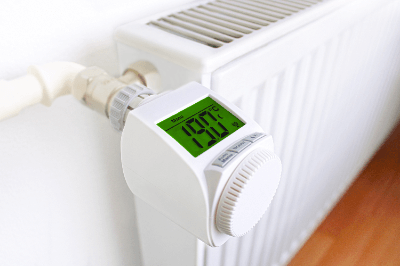What Is a Thermostat?
 A thermostat is a device used in temperature control.
A thermostat is a device used in temperature control.
It is responsible for controlling the operating signals for cooling and heating devices based on the results of temperature detection. The general function of a thermostat is to detect temperature, but some products may also have a function to detect abnormal temperature increases and prevent temperature overshoots.
Usage of Thermostats
Thermostats are commonly used to control either the upper or lower limit of a temperature setting, such as a temperature heater for a water tank.
Other types of thermostats are also available, such as those that control both the upper and lower limits and specify a certain temperature range, as in precision air conditioning, or those that not only control the upper and lower limits of the set temperature but also prevent the temperature from rising to an abnormal level or detect a specified temperature.
In addition to those incorporated into electrical circuits as described above, some are directly incorporated as open/close valves in fluid circuits, such as engine room cooling water flow rate control. In any case, the advantage of thermostats over other types of temperature detectors is that they can be made smaller.
Principle of Thermostats
Among thermostats, the bimetal thermostat uses the phenomenon of metal expanding and contracting due to heat. Since the coefficients of thermal expansion between different metals are different in bimetals, the entire bimetal is curved toward the metal with the relatively smaller coefficient of thermal expansion due to the difference in the magnitude of expansion and contraction caused by temperature changes.
By utilizing this curvature of the bimetal, it is possible to create a circuit in which the contacts open and close in response to temperature. By setting an arbitrary threshold for the opening and closing of the contacts, it is possible to control the circuit such that the power supply of the heat source or cooling source is switched on and off after a certain temperature.
Another advantage of this mechanism is that the element can be miniaturized because it directly utilizes the temperature sensitivity of the bimetal material, rather than actually measuring the temperature and then controlling it electrically. If the thermostat is incorporated into a fluid circuit as an open/close valve, rather than as a contact point in a circuit, it can represent a control valve that opens gradually in response to temperature changes.
Types of Thermostats
Thermostats are devices used to control temperature, and various types of thermostats are used depending on the application.
1. Electronic Thermostats
Electronic thermostats control temperature by computer control rather than by motion signals. This allows for more accurate temperature control in the operating environment.
Temperature control can also be performed automatically, enabling appropriate temperature control and cost reductions in electricity and other expenses. It is mainly used in the industrial field, where it is widely used to control the cooling water temperature of engines and the temperature inside vinyl greenhouses for agriculture.
2. Bimetal Thermostat
Bimetal thermostats consist of two types of metals with different thermal expansion coefficients. When the temperature rises to the set temperature, the contact points composed of the two types of metals separate and the circuit can be interrupted.
A thermostat that uses this principle is called a bimetal thermostat. Bimetal thermostats are used in refrigerators and gas water heaters used in homes.
They are used in many industrial products because of their simple structure and ability to control temperature accurately. Also, its metal construction makes it resistant to breakage even after long-term use.
3. Liquid Expansion Thermostats
Liquid expansion thermostats have a structure in which a liquid with a high thermal expansion coefficient is sealed inside a metal tube. The expansion of the enclosed liquid causes the contact points to operate to control the temperature.
When metal is used as the liquid, the accuracy of temperature measurement is higher. For this reason, the thermocouple is widely used in cooking utensils and refrigeration equipment that require precise temperature measurement.
Another feature of liquid expansion thermostats is that their electrical capacity can be increased. By increasing the electrical capacity, a wider range of temperatures can be detected. For this reason, liquid expansion thermostats are widely used in industrial fields such as large-scale factories that require temperature detection over a wide range.